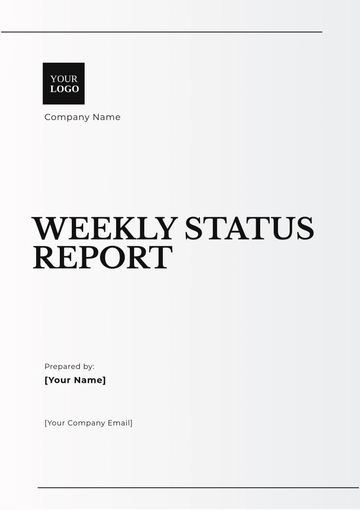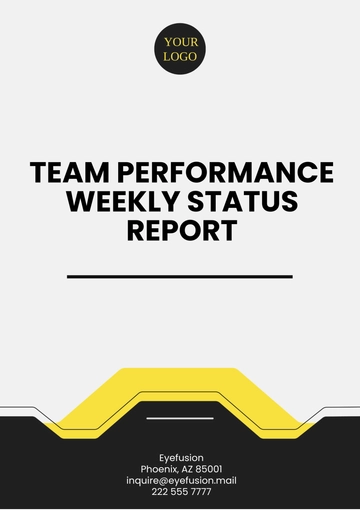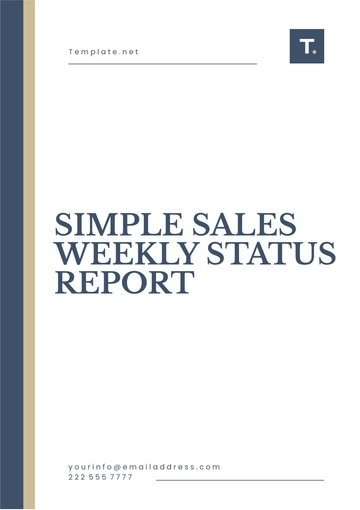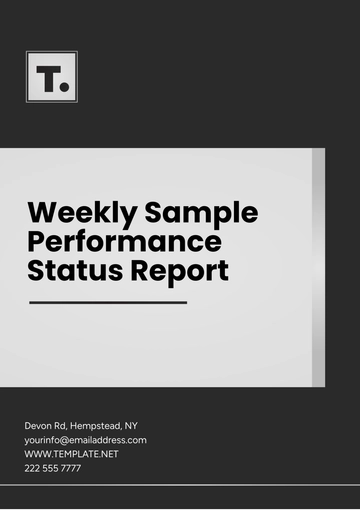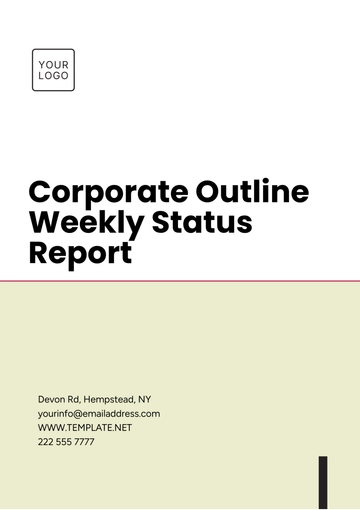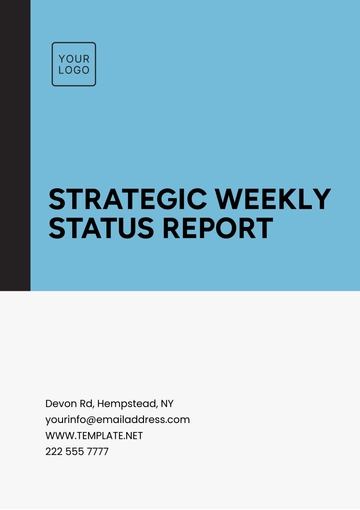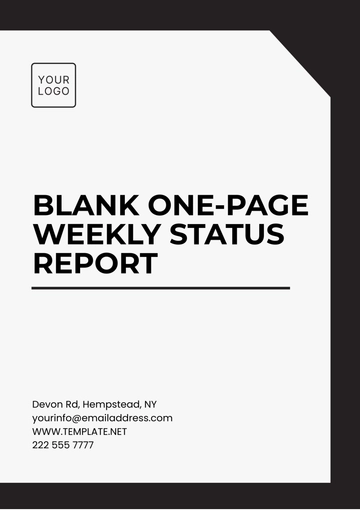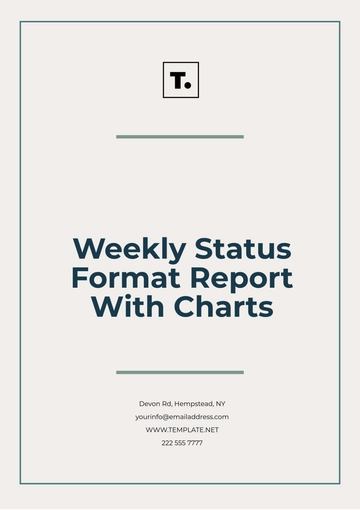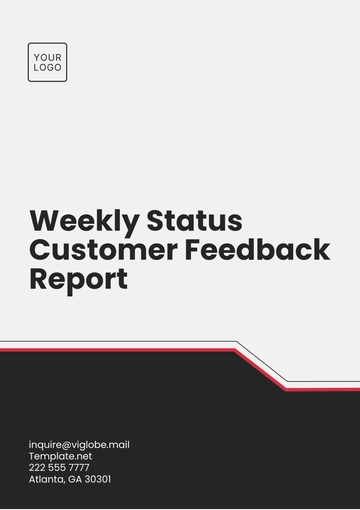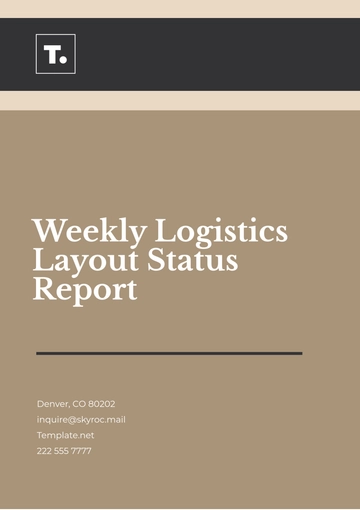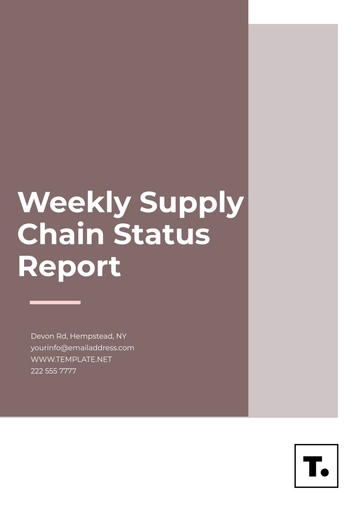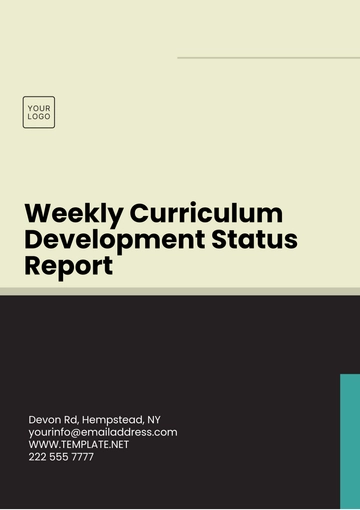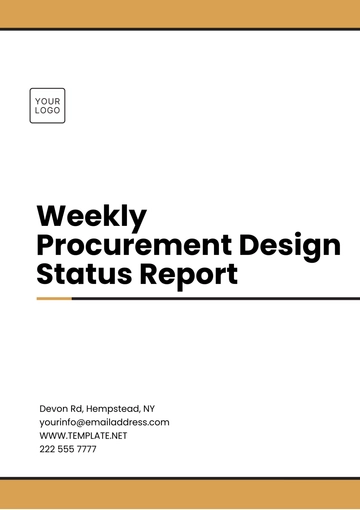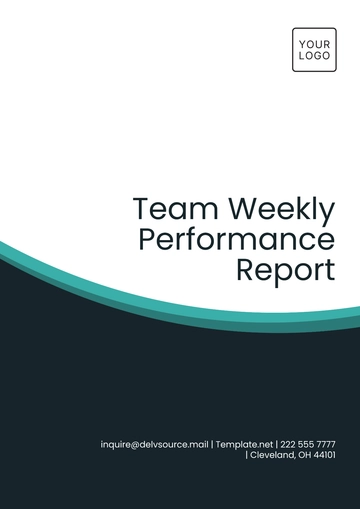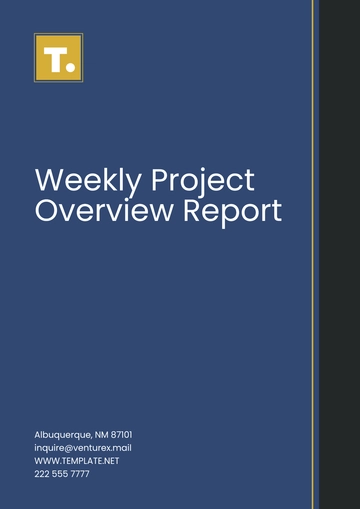Free Car Rental Weekly Report
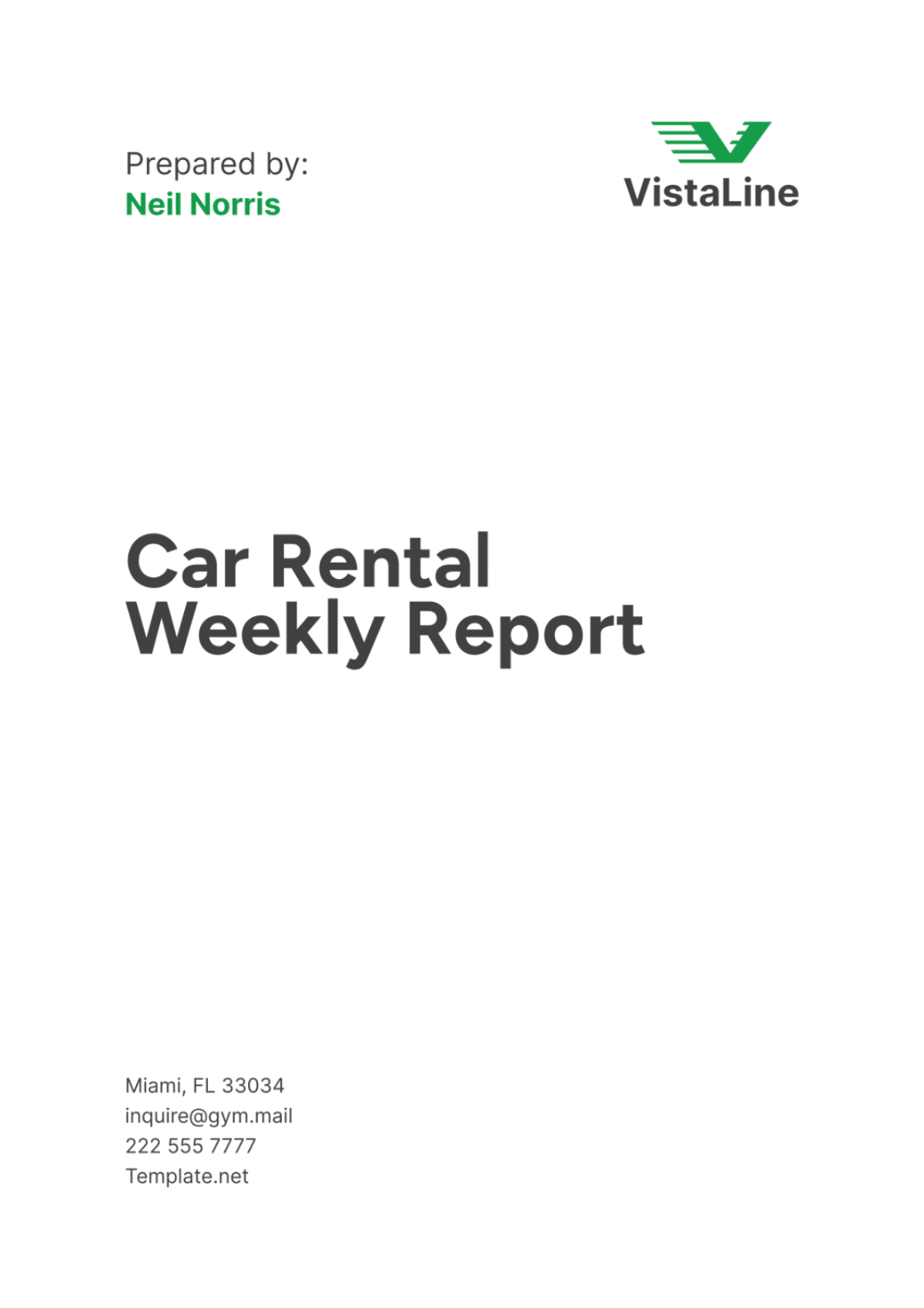
I. Executive Summary
The Car Rental Weekly Report from [Your Company Name] offers a detailed assessment of our operational performance, emphasizing critical metrics such as total rentals, revenue generation, vehicle utilization rates, and customer feedback scores. This comprehensive review enables us to gauge our market presence and operational efficiency accurately.
Moreover, the report delves into the effectiveness of recent marketing initiatives, outlining their influence on rental reservations and customer engagement. It also addresses operational hurdles encountered during the week, proposing actionable solutions to refine service delivery and elevate customer experience. By leveraging these insights, we aim to strategically enhance business operations and ensure sustained customer satisfaction.
II. Key Metrics
This section presents essential metrics from [Your Company Name]'s weekly operations, highlighting performance indicators crucial for strategic decision-making and operational optimization.
Metric | Value | Insights |
|---|---|---|
Total Rentals | 450 | Indicates strong demand and utilization of our rental fleet. |
Revenue Generated | $75,000 | Demonstrates the financial performance and revenue potential. |
Vehicle Utilization Rate | 85% | Reflects efficient management of our vehicle fleet resources. |
Customer Satisfaction Score | 4.7/5 | Highlights high satisfaction levels among our rental customers. |
Marketing Campaign Impact | 15% increase in bookings | Shows the positive impact of recent marketing efforts on rental bookings. |
These metrics underscore our strong performance in rental volume and revenue generation. Our high vehicle utilization rate reflects efficient fleet management, while exceptional customer satisfaction and increased bookings affirm the effectiveness of our marketing strategies. These insights guide our ongoing efforts to deliver exceptional service and maximize business growth.
III. Rental Statistics
This section offers a comprehensive analysis of [Your Company Name]'s weekly rental performance, detailing total rentals, revenue generated, and utilization rates. It also identifies top-performing rental locations, providing valuable insights into operational efficiency and market trends crucial for strategic decision-making and business optimization.
a. Weekly Breakdown
This subsection provides a detailed weekly breakdown of rental performance, showcasing key metrics from [Your Company Name]'s operations.
Date | Total Rentals | Revenue | Utilization Rate |
|---|---|---|---|
01/01/2050 - 07/01/2050 | 150 | $25,000 | 80% |
08/01/2050 - 14/01/2050 | 140 | $23,500 | 85% |
15/01/2050 - 21/01/2050 | 160 | $26,500 | 90% |
b. Top Performing Locations
This part highlights the top-performing rental locations based on total rentals for the week.
Location | Total Rentals |
|---|---|
Location A | 120 |
Location B | 100 |
Location C | 80 |
These detailed insights into weekly rental performance and top-performing locations provide a clear overview of operational efficiency and market demand trends for strategic planning and optimization.
IV. Customer Feedback
This section provides a comprehensive overview of customer sentiment towards [Your Company Name]'s services. It highlights overwhelmingly positive feedback on booking ease, vehicle quality, and customer service. Additionally, it identifies actionable insights for enhancing vehicle availability during peak periods and improving communication on insurance options to further elevate customer satisfaction and service delivery.
a. Summary
Customer feedback has been overwhelmingly positive, with a majority of responses praising the ease of booking, vehicle quality, and customer service. Constructive feedback indicates areas for improvement in vehicle availability during peak times and clearer communication regarding insurance options.
b. Feedback Scores
This table presents detailed feedback scores from customers, reflecting their satisfaction levels across key service areas.
Aspect | Score |
|---|---|
Overall Satisfaction | 4.7/5 |
Booking Process | 4.8/5 |
Vehicle Quality | 4.6/5 |
Customer Service | 4.7/5 |
These feedback scores underscore our commitment to delivering exceptional service experiences while identifying specific areas where enhancements can further elevate customer satisfaction.
V. Marketing Campaigns
This section showcases [Your Company Name]'s proactive approach to marketing, featuring five dynamic campaigns designed to boost brand visibility and customer engagement. With a focus on social media, email newsletters, Google Ads, seasonal discounts, and a referral program, these initiatives have significantly enhanced bookings and website traffic, driving business growth effectively.
a. Current Campaigns
This subsection outlines [Your Company Name]'s five current marketing campaigns aimed at enhancing brand visibility and driving customer engagement.
Campaign Title | Description |
|---|---|
Social Media Promotions | Utilizing platforms like Facebook, Instagram, and Twitter for targeted ad campaigns and promotions. |
Email Newsletters | Regular newsletters highlighting special offers, updates, and new vehicle additions. |
Google Ads Campaign | Pay-per-click (PPC) advertising on Google to capture search traffic interested in car rentals. |
Seasonal Discounts | Offering special discounts during peak travel seasons to attract more customers. |
Referral Program | Incentivizing existing customers to refer new clients with discounts or rewards. |
b. Campaign Impact
This table details the impact of [Your Company Name]'s recent marketing campaigns on business metrics.
Impact Metrics | Details |
|---|---|
Increase in Bookings | A 15% rise in bookings attributed to recent marketing efforts, highlighting campaign effectiveness. |
Traffic Source | Social media campaigns emerged as the primary driver of website traffic and customer engagement. |
These insights illustrate the success of our current marketing strategies in increasing bookings and enhancing brand engagement, underscoring our commitment to strategic marketing initiatives for business growth.
VI. Operational Challenges & Improvements
This section identifies key operational challenges impacting [Your Company Name]'s service delivery and customer satisfaction. It provides detailed insights into issues such as vehicle shortages, staff training, and reservation system inefficiencies. Additionally, it outlines strategic improvements, including fleet expansion, enhanced training programs, and optimized maintenance schedules, to drive operational excellence and customer satisfaction.
a. Identified Challenges
This subsection outlines key operational challenges faced by [Your Company Name], affecting service delivery and customer satisfaction.
Identified Challenges | Details | Impact |
|---|---|---|
High demand resulting in occasional vehicle shortages | Increased bookings leading to limited vehicle availability during peak times. | Customer dissatisfaction due to unavailability of vehicles. |
Need for improved training for new staff | Inconsistent service quality due to varying levels of staff expertise. | Potential decrease in customer service standards. |
Refinement needed in the insurance communication process | Customers facing confusion regarding insurance options and coverage. | Reduced customer trust and potential disputes. |
Delays in vehicle maintenance and turnaround time | Slower servicing and preparation of vehicles for rental. | Longer waiting times for customers and potential booking delays. |
Inefficient reservation system leading to overbooking | Technical glitches causing double bookings and reservation issues. | Customer frustration and loss of bookings. |
Insufficient customer support during high-demand periods | Limited availability of support staff to handle increased customer inquiries. | Lower customer satisfaction and longer response times. |
Limited variety of rental options for different customer needs | Lack of diverse vehicle types to cater to varying customer preferences. | Customers seeking alternative rental companies. |
Inadequate handling of customer feedback and suggestions | Slow or ineffective response to customer complaints and feedback. | Negative impact on customer loyalty and brand reputation. |
Difficulty in managing promotional offers and discount codes | Complexities in implementing and tracking various promotional campaigns and discount codes. | Confusion and errors in billing and customer dissatisfaction. |
Challenges in fleet management during seasonal fluctuations in demand | Inability to accurately predict and prepare for seasonal peaks and troughs in demand. | Operational inefficiencies and potential revenue loss. |
b. Suggested Improvements
This table details proposed solutions to address operational challenges and optimize service efficiency.
Suggested Improvements | Details | Expected Benefits |
|---|---|---|
Expand the fleet to meet peak demand | Invest in additional vehicles to ensure availability during high-demand periods. | Higher customer satisfaction and increased bookings. |
Implement a comprehensive training program for all new hires | Develop structured training modules covering all aspects of customer service and operations. | Consistent service quality and improved staff performance. |
Enhance the clarity and availability of insurance information for customers through improved communication | Create easy-to-understand insurance guides and FAQs accessible online and at rental locations. | Better customer understanding and trust. |
Optimize vehicle maintenance schedules to reduce turnaround time | Implement a predictive maintenance system to streamline vehicle servicing and reduce downtime. | Faster vehicle availability and higher operational efficiency. |
Upgrade the reservation system to prevent overbooking | Invest in advanced reservation management software with real-time booking updates and error handling. | Minimized booking errors and improved customer experience. |
Increase customer support staff during high-demand periods | Hire additional support staff or implement chatbots to manage increased inquiries efficiently. | Faster response times and higher customer satisfaction. |
Diversify the fleet to offer a variety of rental options | Introduce different vehicle categories (e.g., luxury, economy, SUVs) to cater to diverse needs. | Attract a broader customer base and increase market share. |
Establish a robust feedback management system | Implement a system to track, analyze, and respond promptly to customer feedback and complaints. | Enhanced customer loyalty and improved service quality. |
Simplify the management of promotional offers and discount codes | Use specialized software to manage and track promotions accurately and efficiently. | Reduced billing errors and increased customer satisfaction. |
Improve demand forecasting and fleet management for seasonal variations | Utilize data analytics to predict demand trends and adjust fleet size accordingly. | Optimized operations and maximized revenue during peak seasons. |
VII. Conclusion
This weekly report has provided a comprehensive overview of [Your Company Name]'s performance, highlighting key metrics in rental statistics, customer feedback, and marketing campaign impacts. While operational challenges such as vehicle shortages and training gaps were identified, proposed improvements offer actionable solutions to enhance service delivery.
Through strategic marketing initiatives and continuous operational enhancements, [Your Company Name] is well-positioned to optimize business performance and maintain high levels of customer satisfaction. By addressing these challenges and leveraging opportunities, we aim to sustain growth and strengthen our market position in the car rental industry.
- 100% Customizable, free editor
- Access 1 Million+ Templates, photo’s & graphics
- Download or share as a template
- Click and replace photos, graphics, text, backgrounds
- Resize, crop, AI write & more
- Access advanced editor
Streamline your car rental business with the Car Rental Weekly Report Template from Template.net. This fully customizable and editable document helps you keep track of rental activities, revenue, and fleet management. Enhance efficiency and accuracy with ease, as our template is fully editable in our Ai Editor Tool. Maximize your productivity and gain valuable insights today!
You may also like
- Sales Report
- Daily Report
- Project Report
- Business Report
- Weekly Report
- Incident Report
- Annual Report
- Report Layout
- Report Design
- Progress Report
- Marketing Report
- Company Report
- Monthly Report
- Audit Report
- Status Report
- School Report
- Reports Hr
- Management Report
- Project Status Report
- Handover Report
- Health And Safety Report
- Restaurant Report
- Construction Report
- Research Report
- Evaluation Report
- Investigation Report
- Employee Report
- Advertising Report
- Weekly Status Report
- Project Management Report
- Finance Report
- Service Report
- Technical Report
- Meeting Report
- Quarterly Report
- Inspection Report
- Medical Report
- Test Report
- Summary Report
- Inventory Report
- Valuation Report
- Operations Report
- Payroll Report
- Training Report
- Job Report
- Case Report
- Performance Report
- Board Report
- Internal Audit Report
- Student Report
- Monthly Management Report
- Small Business Report
- Accident Report
- Call Center Report
- Activity Report
- IT and Software Report
- Internship Report
- Visit Report
- Product Report
- Book Report
- Property Report
- Recruitment Report
- University Report
- Event Report
- SEO Report
- Conference Report
- Narrative Report
- Nursing Home Report
- Preschool Report
- Call Report
- Customer Report
- Employee Incident Report
- Accomplishment Report
- Social Media Report
- Work From Home Report
- Security Report
- Damage Report
- Quality Report
- Internal Report
- Nurse Report
- Real Estate Report
- Hotel Report
- Equipment Report
- Credit Report
- Field Report
- Non Profit Report
- Maintenance Report
- News Report
- Survey Report
- Executive Report
- Law Firm Report
- Advertising Agency Report
- Interior Design Report
- Travel Agency Report
- Stock Report
- Salon Report
- Bug Report
- Workplace Report
- Action Report
- Investor Report
- Cleaning Services Report
- Consulting Report
- Freelancer Report
- Site Visit Report
- Trip Report
- Classroom Observation Report
- Vehicle Report
- Final Report
- Software Report
